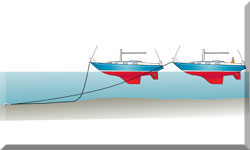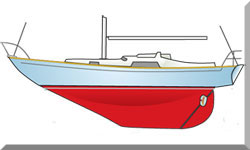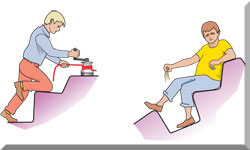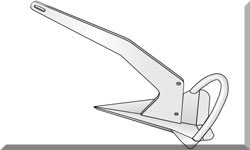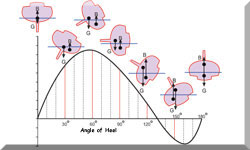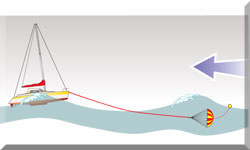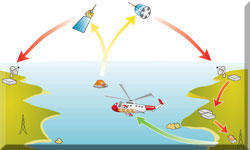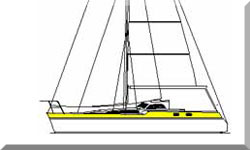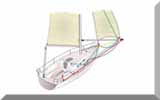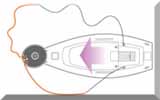- Home
- Knots, Bends & Hitches
- Rolling Hitch
The Rolling Hitch
How to Tie It & When to Use It
The Rolling Hitch, also known as the Magners or Magnus Hitch, is a very useful friction hitch for the sailor. In fact there are two specific situations in which it has no equal:
- Freeing a riding turn. Attach, with a rolling hitch, a line to the sheet leading to the winch where the riding turn has locked it solid. Take the standing part to another winch and tension it such that the load is taken off the jammed sheet. With the jammed sheet now slackened it will be possible to release the riding turn.
- Attaching an Anchor Snubber. Tie the snubber line to the anchor chain or rope warp with a rolling hitch and tie off the standing part to a deck cleat other strong point.
In ether of these situation the rolling hitch won't slip if you've tied it correctly.
Another attribute of the rolling hitch is its ability to slide along the rail, spar or rope around which it's tied - when you want it to to, that is. Just grip the entire knot and move it bodily, but try and pull it along with the standing part and it will defiantly refuse to move.
How to Tie the Rolling Hitch
For the purpose of the illustrations we've employed a wooden spar, but it could similarly have been a stanchion, rail, guardwire or taught rope.
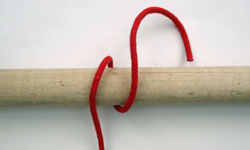
Stage 1
Take a turn around the spar...
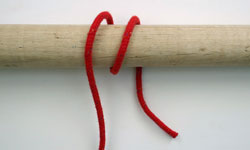
Stage 2
... followed by a second one;
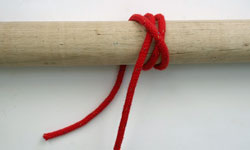
Stage 3
Now take another turn back in the other direction over the first two turns...
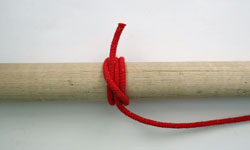
Stage 4
...and tuck the working end back under itself.
The rolling hitch will move along the spar if pushed by hand, but trying to move it by pulling on the standing part of the line will get you nowhere.
What is the difference between a clove hitch and a rolling hitch?
What is the difference between a clove hitch and a rolling hitch?
The clove hitch and rolling hitch are both useful knots, but they serve different purposes and have distinct structures. Here’s a comparison of the two:
Clove Hitch:
- Structure: Formed by making two half hitches around an object in opposite directions.
- Uses: Commonly used to start lashings, secure lines temporarily to posts or spars, and for non-critical applications. It's quick to tie and adjust.
- Security: Can slip under load, especially with slippery ropes or varying tension. Best for temporary and non-critical securing.
Rolling Hitch:
- Structure: Made by wrapping the rope around an object twice in the same direction, then crossing the rope over itself and making a final wrap in the opposite direction before tucking the end under the final wrap.
- Uses: Used to attach a rope to another rope or object under tension, often in sailing for securing lines to a taut rope. It's ideal for situations where the load direction changes, as it maintains grip.
- Security: More secure than the clove hitch under tension and less likely to slip. Holds well even when the direction of the pull changes.
While the clove hitch is quick and easy for temporary securing, the rolling hitch is more secure for tying onto objects under tension or when the load direction varies.
What is a rolling hitch used for?
What is a rolling hitch used for?
The rolling hitch is a very versatile and secure knot used in various applications, particularly where you need to attach a rope to a stationary or another line under tension. Here are some common uses:
- Sailing and Boating: Securing a rope to a taut line, such as a mooring line or a stay. Making temporary repairs or adjustments to rigging.
- Climbing and Rescue: Attaching a rope to another rope under tension, such as when creating a Prusik loop for ascending or descending a rope. Using in hauling systems or friction hitches.
- Camping and Outdoor Activities: Securing a guy line to a tent or tarp. Adjusting the tension in lines or securing items to a fixed point.
- General Use: Tying a rope to a pole or post when the direction of pull might change. Creating a non-slip attachment that can be adjusted easily.
The rolling hitch is praised for its ability to hold under varying loads and its ease of untying, even after being subjected to tension.
What can I use instead of rolling hitch?
What can I use instead of rolling hitch?
There are several alternatives to the rolling hitch that can be used depending on the specific application. Here are a few options:
1. Taut-Line Hitch:
- Uses: Ideal for creating adjustable loops that can slide and then hold under tension, making it perfect for securing tent guy lines or tarps.
- Structure: Similar to a rolling hitch but allows for easy adjustment of the tension in the line.
2. Prusik Knot:
- Uses: Commonly used in climbing and rescue for creating a friction hitch that can slide along a rope but locks under load.
- Structure: Made by wrapping a loop of cord around a rope several times, creating a secure and adjustable connection.
3. Anchor Hitch (Fisherman’s Bend):
- Uses: Frequently used in marine applications to secure a rope to an anchor or a heavy object.
- Structure: Creates a strong and secure attachment, similar to a rolling hitch but with additional wraps for extra security.
4. Constrictor Knot:
- Uses: Provides a very secure binding, great for tying bundles or securing objects where a tight hold is needed.
- Structure: Similar to a clove hitch but with an additional crossing turn, making it more secure and harder to untie.
5. Half Hitch with a Backup Knot:
- Uses: For temporary or less critical applications where a quick and adjustable securing method is needed.
- Structure: A simple half hitch followed by a second hitch or a stopper knot for added security.
Each of these knots has its own strengths and ideal applications, offering alternatives depending on what you need the knot to accomplish.
Recent Articles
-
Tame the Tempest: The Jordan Series Drogue for Sailboat Storm Survival
Jul 02, 25 04:04 PM
Facing heavy weather offshore? Discover how the Jordan Series Drogue provides unmatched sailboat capsize prevention and control. Get crucial installation tips and understand this vital storm survival… -
Warwick Tandem Keel: Design, Benefits & Why Sailors Love It
Jul 02, 25 08:19 AM
Explore the Warwick Tandem Keel's unique design and benefits for recreational sailors. Learn how this innovative dual keel boosts upwind performance, offers shallow draft access, and why it's a niche… -
Gozzard Sailboats: Timeless Cruisers for Liveaboard & Offshore Sailing
Jul 01, 25 03:42 PM
Explore Gozzard sailboats: their heritage, robust construction, and comfortable liveaboard design. Discover why these classic cruising yachts are built to last.

